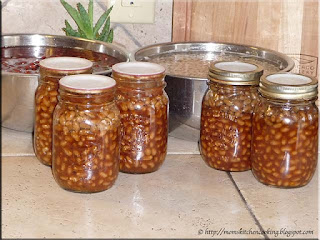While our previous house was on the market and once we sold, I purposely let our supply of home canned foods dwindle down. The end result was less cases of filled jars to move but ultimately running out of some of the home canned staples we rely on. One of those foods were home canned legumes like kidney beans, red beans, navy beans as well as some of the various products I can using legumes like a variety of brown beans and bean soups. I spend three days last week canning up a few dried bean products. I am nowhere near the amounts I need for a year but it was a start.
At the end of Day 1 I had from left to right, 3 - 500 ml small red beans, 1 -500 ml small red/black bean mix, 4 - 500 ml black beans, 4 - 500 ml red kidney beans and 4 - 500 ml dark red kidney beans. The jar to the right with the ring still on did not seal so went into the fridge leaving me 15 jars for the pantry. It had a silver metal 2 piece snap lid on that many home canners don't like because of increased seal failures. You will notice I am using the re-usable Tattler lids more in home canning. They currently have free shipping so I ordered more.
Salted pork belly is an ingredient commonly used in brown aka baked bean recipes. It is that flavour that makes baked beans so tasty. This is a cut of meat from the belly of the pig that has been salt cured but not smoked. You can find larger pieces at most butcher shops. Smaller pieces about 4 oz are usually available where bacon is found in the supermarkets. If you cannot find salted pork belly you could cure your own using Morton's Tender Quick or you could substitute a thick cut bacon. Substituting will give a bit different flavour as most bacon is smoked. Thick cut bacon is also more expensive for this particular use but the remainder can always be used for another dish.
We had some of the tastiest baked beans form Mike's Smokehouse BBQ and Grill in Tampa, Florida. I have been working on a clone recipe that can be home canned. I'm almost there but not quite. Day 2 I ran a test batch of my newest pork & bean recipe. I did tweak the method a bit by putting less beans in the jars. That did give better results for the jars that sealed (right) but two jars did not seal. I used all Tattler lids my explanation is I somehow missed one of the two critical steps - tighten then turn back a quarter inch before putting in the canning AND immediately tighten when removed from the canner. So, I am chocking the seal failures for this load as user error. The nice thing is I had a chance to taste the product to see how close I came. I still need to do a bit more tweaking. In the background are soaked beans ready for that day's canning.
I had just a little of the sauce from the pork & beans to use up. From left to right, I ended up with 1 - 500 ml jar of plain navy beans, 2 - 500 ml jars pork & beans, 4 - 500 ml jars maple baked beans, and 7 - 500 ml jars of dark red kidney beans. Most of this canner batch had the Tattler lids. I did have one seal failure (far right) and that was a Tattler lid so I ended up with 13 jars for the pantry.
Over the three days of canning I ended up with a total of 31 jars of dried bean products for the pantry. It's not a bad start towards restocking but I need a few more canning sessions to get my bean stores up where they should be. Any jar that did not seal is not wasted. It goes into the refrigerator to be used within a few days. Seal failures are not the evil monster some home canners make them out to be. While I am certainly not used to having this many seal failures in only three canning sessions, it is an opportunity for me to tweak the product, do a bit of troubleshooting and perfect my technique. Since I plan on switching over to using only Tattler and glass inserts, both of which are re-usable (aka cost effective and eco-friendly) perfecting my technique using them is a must. All in all, I am pleased with last week's canning results!








0 food lovers commented:
Post a Comment